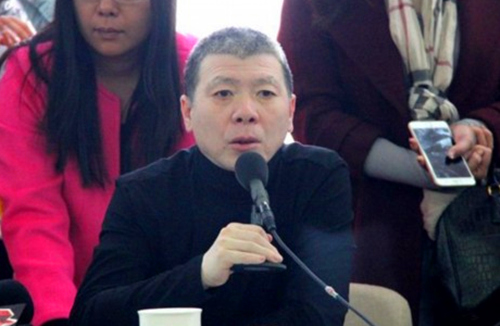Feng Xiaogang wants traditional Chinese characters back
- By Zhang Rui
 0 Comment(s)
0 Comment(s) Print
Print E-mail China.org.cn, March 5, 2015
E-mail China.org.cn, March 5, 2015
Director Feng Xiaogang said on Wednesday in Beijing that he is ready to raise a joint proposal with actor Zhang Guoli to suggest the return of traditional Chinese characters to schools.
 |
|
Director Feng Xiaogang speaks at a panel discussion at the third session of the 12th National Committee of the Chinese People's Political Consultative Conference in Beijing on March 4, 2015. [China.org.cn] |
Feng, a member of the Chinese People's Political Consultative Conference (CPPCC), is attending the third session of the 12th National Committee of the CPPCC, the country's top political advisory body. A total of 2,153 members of the CPPCC National Committee will discuss major issues concerning the country's development during the annual session until March 13.
"This is about cultural inheritance," Feng said, and he hopes China can restore some of the traditional Chinese characters.
For example, he said, in "qin ai" (亲爱, which means "dear"), The traditional Chinese character for "qin" is "親", and "ai" is written in traditional characters as "愛." Both characters have more parts than the simplified Chinese characters (the traditional "qin" has an additional part "見" meaning "see," and "ai" has an additional Chinese character part "心" meaning "heart") .
"The simplified Chinese characters don't have the 'see' and 'heart' components in them, which reduces the meaning of the Chinese characters," Feng pointed out.
"Now children can learn English, French and Italian, but why can't they also learn some traditional Chinese characters?" the director asked. He said he has discussed the matter with actor Zhang Guoli, and hopes elementary and high school textbooks can include 50-200 of the most meaningful traditional Chinese characters, which "will let the children know about the most important part of Chinese traditional culture," he said.
He added, "Don't let these characters get lost in modern culture. When children learn to write, they also plant good cultural seeds in their heart."
Feng Jicai, another CPPCC member, agreed with Feng Xiaogang, "The simplified Chinese characters are for convenience. We cannot completely restore traditional Chinese characters, but we can teach students how to write traditional ones and tell them what the cultural connotations are in them. It is very necessary."
Zhang, who was making the proposal with Feng Xiaogang , said: "President Xi Jinping said we should tell good Chinese stories. When we promote the beauty of Chinese characters, we have to understand the meaning and cultural connotations hidden in them."
Simplified Chinese characters are standardized Chinese characters for use on the Chinese mainland. Along with traditional Chinese characters, it is one of the two standard character sets of the contemporary Chinese written language. The government of the People's Republic of China has promoted simplified characters for use in printing since the 1950s and 1960s in an attempt to increase literacy. They are officially used on the Chinese mainland and in Singapore.
Traditional Chinese characters, the original form of the Chinese characters, first appeared in their modern form with the emergence of the clerical script during the Han Dynasty, and have been more or less stable since the fifth century. The traditional characters are currently used in Taiwan, Hong Kong and Macao and are widely used overseas.






Go to Forum >>0 Comment(s)